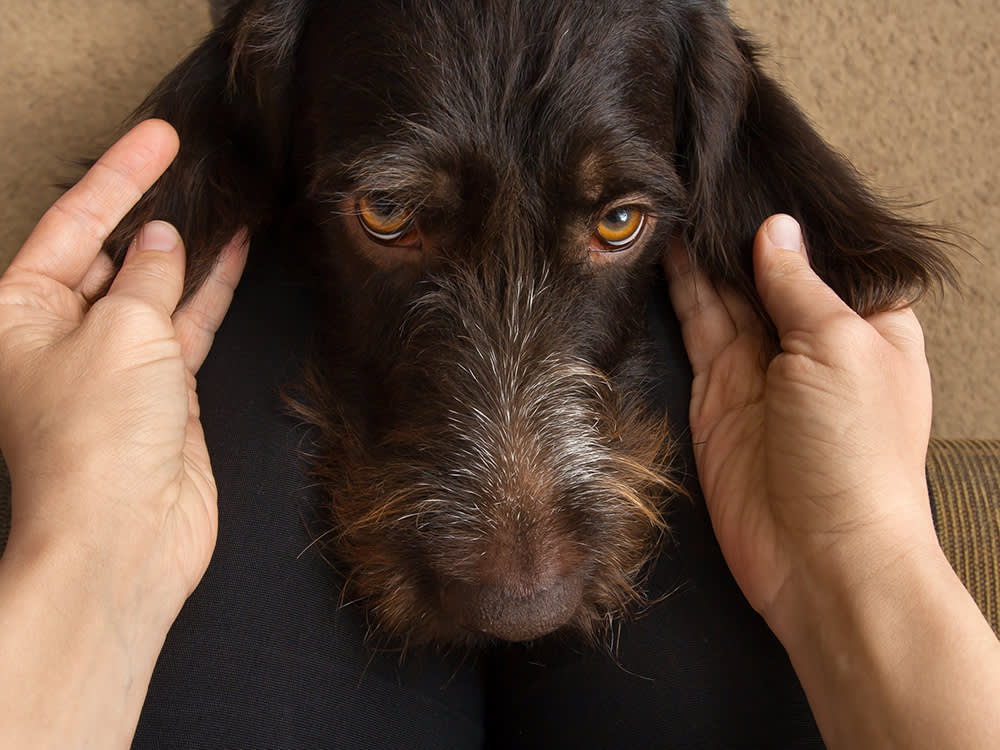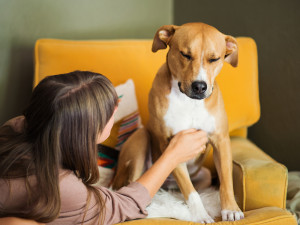DIY Physical Exam Part 2 — How to Check Your Dog for Infections
Veterinarian Dr. Shea Cox on how to assess your dog’s eyes, ears, nose, and mouth.
In this series, we’re helping pet parents gain confidence in conducting basic health checks on their dogs. This installment will show you how to examine your dog’s eyes, ears, and nose at home.
Start with examining your dog’s face and head for this portion of the physical exam: check the nose for discharge and boogers, and the eyes and ears for infections. In the next part of our series, we will continue with the chest, and lastly, the abdomen. At the completion of this series, you should feel totally prepared to perform a screening exam on your dog.
How to Check a Dog’s Nose
Normal Nose
Smooth, soft, and clean. It is a misconception that a dry, warm nose means illness; sometimes a normal nose can appear slightly dry as well as warm to the touch. A healthy nose should feel like soft, supple leather — it is not necessarily always cool, wet, and moist.
Nasal discharge that is scant, clear, or watery can be normal.
Abnormal Nose
A dog’s nose which is excessively dry and cracked or crusty is abnormal.
If your dog has any colored nasal discharge or dripping; a green, yellow, or white discharge generally indicates a bacterial infection. You should report this information to your vet.
It is not typical for a dog to have a nose bleed.
How to Examine a Dog’s Eyes
Normal Eyes
Your dog’s eyes should be bright, moist, and clear.
Pupils are equal in size.
The whites of the dog’s eye should not appear colored and should have only a few visible blood vessels.
Check your dog’s pupillary light reflex: Pupils should shrink equally when a bright light is shined into either eye and enlarge equally when the eyes are held closed or the room darkened.
Abnormal Eyes
Dull, sunken eyes can indicate severe dehydration in dogs.
Eyes that appear red, dry, and “bloodshot” can indicate conditions such as uveitis, KCS (“dog dry eye”), severe dehydration, or other systemic illnesses.
Red or swollen upper and lower eyelids sometimes with discharge can indicate conjunctivitis.
Swollen eyelids causing the eye to look semi-closed may indicate an allergy or a foreign body in the eye or an injury.
Thick discharge from eyes is abnormal. A little grey “eye booger” in the morning is normal, just like in us humans, but be concerned if you notice any eye discharge with green or yellow color to it as this can be indicative of an eye infection.
One or both eyes not centered: this can indicate a tumor or infection behind the eye, as well as other pathology.
Pupils unequal in size: this can indicate head trauma, a possible tumor, other neurologic problems to name a few.
Squinting or tearing of the eyes: this can indicate an ulcer or scratch on the cornea, which is the layer of cells covering the eye.
Abnormal eye colors in dogs that indicate eye infections or problems are yellow (jaundice), or red (bloodshot); pay close attention to the color of the whites of your pet’s eyes.
The appearance of blood in the eye (known as hyphema): this can indicate exposure to rat bait or other causes of your pet’s blood not being able to properly clot.
Pupils fail to respond, or respond differently from one another, when a bright light is shined into either eye.
How to Inspect a Dog’s Ears
Chronic ear problems are common in pets, and are often a result of narrow ear canals or allergies to inhaled pollen (like hay fever in people) that are then complicated by secondary infections with bacteria or yeast. Dog ear infections can be painful and head shaking can lead to an accumulation of blood in the floppy part of the ear, known as an aural hematoma (or dog ear hematoma). Symptoms of ear infections in dogs include head shaking, scratching at or rubbing the affected ear, discharge, bad odor, redness inside the ear, swelling of the ear canal, pain, itchiness, and crusts or scabs inside the ear or along the ear margin. If you suspect that your dog may be suffering from an ear infection, reach out to your vet.
Dogs with particularly hairy ear canals can suffer more from ear infections; regular check ups with your vets are essential to ensure that the ear canals have good, clear air flow to keep their ears healthy.
How much do you spend on your pet per year?
Normal Ears
Skin smooth and without wounds.
Clean and dry.
Almost odor-free.
Pain-free when you massage them, especially at the base of the ear.
Dog is not shaking head.
Abnormal Ears
Wounds, scabs, bleeding, or any sign of rash is abnormal in dogs ears.
Crust, moisture, or other discharge in ear canal can be a sign of an ear infection.
Any strong odor. If your dog’s ears smell, that’s a bad sign.
Atypical carriage for breed; for example, a droopy ear in a breed with normally erect ears.
Painful or swollen ears.
Reluctant to let someone touch their head.
Shaking their head.
Holding their head to one side.
How to Check a Dog’s Mouth
Normal Mouth
Teeth are clean and white.
Gums are uniformly pink and moist to the touch (they should not feel dry or sticky).
Capillary refill time (CRT): to assess, press on the gum tissue with your finger or thumb and then release quickly; the part you just pushed on will turn white, and you will then watch the color return to the gums; this is a crude assessment of how well the heart and circulatory system are working as well as hydration status of you pet. A normal CRT is 1 to 1.5 seconds for the color to return; this can be a difficult test to interpret sometimes (for example, if your pet has dark or pigmented gums), and should not be relied upon as definitive evidence that your pet is sick or healthy.
Abnormal Mouth
Tartar accumulation around where the teeth meet the gums.
The gums are red: this can indicate severe dehydration, shock, heat stroke, or sepsis (severe infection in the body).
Gums are bluish or purple: this indicates inadequate oxygen to the body; this can be noted with lung disease, heart disease, or any disease that impairs proper oxygen to the body.
Gums are pale: this is due to lack of blood or shock and possible causes are internal bleeding (such as a mass on a spleen that suddenly ruptures and bleeds — very common in older dogs), trauma, or shock (such as when a dog has been hit by a car), and immune mediated diseases.
Gums that appear to have little bruises: this is known as petechiation and is generally seen with rat bait toxicity or other problems with the body’s ability to clot the blood.
Gums are inflamed, “spongy” looking, or sore in appearance.
A sluggish CRT, or dry and sticky gums.
Bad smell from the mouth.
Growths or lumps anywhere in the mouth.
Broken teeth.
Bleeding, sore, or swollen gums.
Loose teeth.
That completes the head exam. Up next, you will learn about how to examine the chest area, known as the thorax.
Part 3: Examine Your Dog’s Thorax (Neck, Chest, and Breathing)
Part 4: Examine Your Dog’s Stomach Area and Musculoskeletal System
Consult your veterinarian if you’re concerned about any of these dog physical exam findings — early recognition can save your dog’s life.





